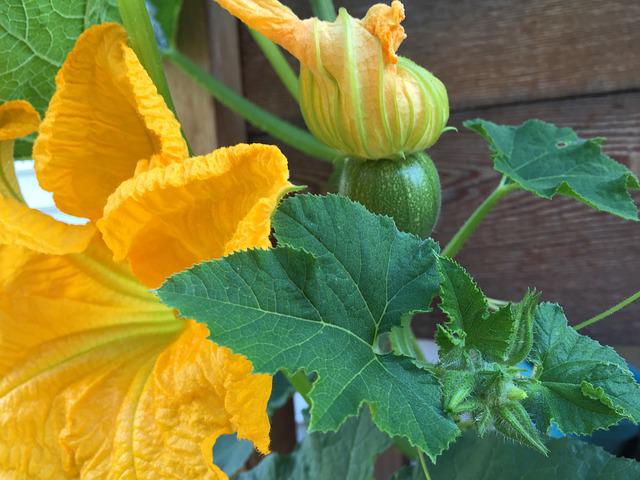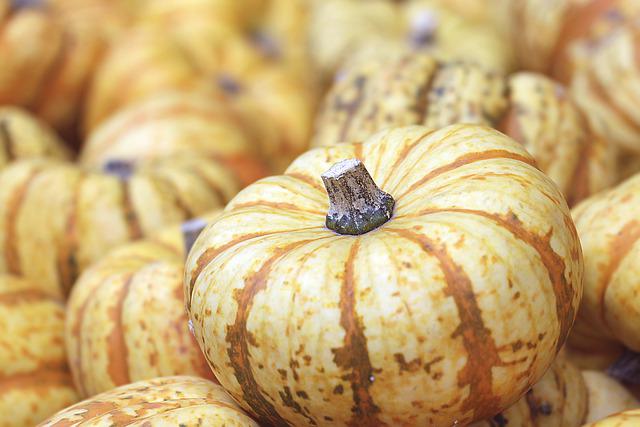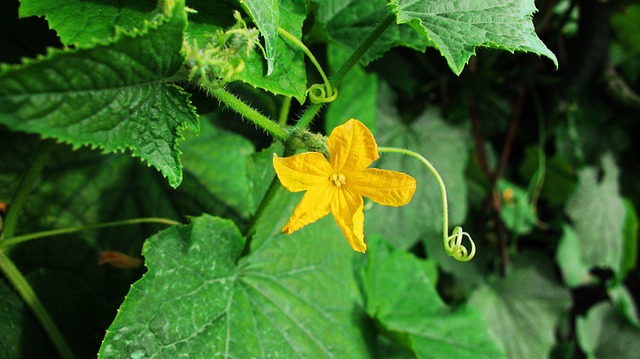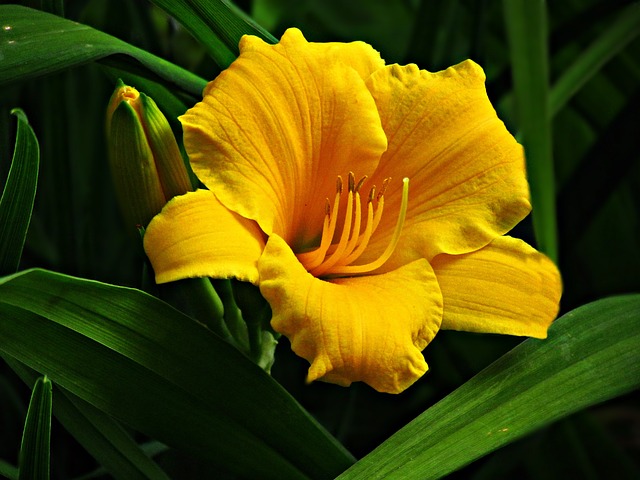Do Pumpkins Have Flowers?

Pumpkins are technically fruits, and as such, they do contain flowers. Some pumpkins may have small flowers on the stem, while others may have larger flowers that are well-developed. The flowers on a pumpkin are typically bright orange or yellow, and they can be quite beautiful when in bloom. Read more about pumpkin flowers.
Table of Contents
What Does the Flower of a Pumpkin Look Like?
Male and female flowers are present on the pumpkin plant, and both are required for fruit production. All pumpkin flowers are big, orange, star-shaped blooms that grow on the pumpkin vine. The male and female flowers are different in some important ways, though.
There are a few things that make male flowers easy to spot:
- A thin, long stem
- A soft flower bottom
- Inside the petals, the stamen is fuzzy and covered in pollen.
- Usually, the first things to bloom on your pumpkin plants are the leaves (about a week before the female flowers appear)
There are a few things that make it easy to spot the female flowers:
- A thicker stem that is shorter
- A stigma is a group of shorter, non-fuzzy parts in the middle of a flower.
- An ovary bulge at the bottom of the flower
- show up a few days after the first male flowers
When Do Pumpkin Flowers Bloom?
Usually, flowers start to grow on a pumpkin vine after growing for a few weeks and are a few feet long. If you planted your pumpkin in May, it would start to bloom between the middle of June and the beginning of July. Once flowers start to grow, a healthy plant will keep making flowers until it freezes. If you want an orange pumpkin in September or October, the pumpkins should be growing on the vine by the middle or end of August.
How Pumpkins Get Pollinated
Usually, each flower only lasts a day or two, so the pollination window is pretty short.
This is what happens when pumpkins are pollinated:
- The same plant makes both male and female flowers.
- A bee, moth, or fly that spreads pollen is drawn to the flowers by sight or smell.
- When a pollinator lands on a male flower, it picks up pollen, then puts it on one or more female flowers.
- The male pollen goes down a “pollen tube” to an ovary in the female flower. One male gamete joins with an egg to make a fruit, which starts to grow inside the flower and then on the outside.
- Male pollen moving into a female flower is the most important part of this process. Only this will give you fruit.

After They Bloom, How Long Do Pumpkins Take To Grow?
It depends on what kind they are! Some pumpkins can be picked 90 days after planting and about 70 days after they are pollinated. However, others can take up to 110 days or even longer.
Pumpkins that are smaller tend to grow faster than bigger pumpkins. They also tend to do better in places with cold winters and short growing seasons. If you’re growing mini and small pumpkins, trellising can be a great way to keep the fruits off the ground, protect them from bugs in the soil, and save space in the garden.
You can also help your pumpkins grow by cutting off the ends of the vines where they are too long. This makes the plant put its energy into making the fruit grow instead of spreading out.
But make sure not to cut off any big leaves. The wide leaves protect the pumpkin’s skin from getting burned by the sun. So be sure to leave a lot of shade-giving plants.
Some gardeners also find that putting the pumpkins on pieces of cardboard helps them grow. This keeps the pumpkin off the ground and stops rot from starting on the bottom. It also makes it easier to turn the pumpkin if you want it to be perfectly round.
Common Problems of Blooming Flowers
No Blooms
Pumpkin growers get nervous while waiting for the first flowers to bloom and the first pumpkins to grow. We’re not sure what’s wrong. Most of the time, it’s just our worry and restlessness. We haven’t seen a pumpkin since last year, after all. Most of the time, our worry will go away quickly. For now, we suggest a dose of phosphorous fertilizer. This helps the plant bloom and set fruit. Read more in Phosphorous’s Role. We also suggest that you cut back on nitrogen fertilizers during the blooms stage because too much nitrogen can slow down blooming.
Male-Only Flowers
It is completely normal for men to arrive first. Moreover, they do so in great numbers. A week or so passes, and you begin to suspect there is a problem when no women appear. Typically, the female flowers appear 10 to 14 days after the first male flower. There will only be a few ladies at a time once they appear. The male flowers outnumber the female flowers significantly.
Only Flowering Females
It is unusual for female flowers to bloom first. Occasionally this occurs, and there are pollen-rich male flowers. This situation should be temporary, and men will undoubtedly arrive. More female and male flowers will continue to bloom throughout the season, providing ample opportunities for successful pollination. There are hypotheses as to why females sometimes arrive first. Some are related to the fertility of the soil. Others suggest that early-season frosts may predispose the plant to this condition. Determine the soil’s fertility. Phosphorous levels must be satisfactory to high. Nitrogen levels should be moderately low to satisfactory but not excessive.
Two things can be done if male flowers are scarce or absent. First, collect mature male flowers and place them in a glass of water. They should be refrigerated. Utilize them to manually pollinate when necessary. They last up to a week in the refrigerator. You can also request a few male flowers from a friend who grows pumpkins.
Flowers Do Not Bloom
The majority of the time, a pumpkin grower who believes the flowers are not opening has missed the event. Female flowers only bloom for a single morning, often closing before noon. Cloudy and wet weather can prevent a flower from opening.

Is Pumpkin Flower Edible?
You can, after all! In addition to the pumpkin squash’s flesh, seeds, and skin, pumpkin flowers are completely edible.
Traditionally used in Mediterranean and Southern Indian cuisines, pumpkin flowers have a strikingly similar flavor to that of pumpkin squash. In particular, Vitamin C and B9 are abundant in pumpkin blossoms, according to the website Health Benefits Times.
Male flowers are the most commonly harvested for fresh eating because female flowers produce fruit.
It is possible to remove the male flower after hand-pollinating your pumpkins. You can also wait for the male flowers to wilt naturally before harvesting. As soon as possible, cook and eat the flowers, preferably on the same day.
As an edible garnish, you can pan-fry pumpkin flowers and use them as a garnish on salads. Fried and battered are two other popular methods of preparation that are great for outdoor dining in the summer!
What Is Causing Pumpkins To Not Produce?
- Flowers for women are scarce.
- Without pollinators, pumpkins will not produce fruit because bees pollinate their flowers.
- Vineyards may not produce fruit if they are subjected to temperatures above 95 degrees F on both days and nights.
- Vines are unable to produce fruit due to a lack of light.
- Planting vines too late in the season means they won’t have enough time to produce fruit.
- Pumpkins are susceptible to a wide range of pests and diseases, all of which can have a negative impact on fruit production. Don’t be concerned if your vines appear healthy.
What Pumpkins Require to Produce Fruit
- Full exposure to the sun. More than eight hours per day
- Well-drained soil with a high level of fertility
- Water regularly
- fertilization by way of general-purpose veggie food additives
- Vine growth and branching necessitate a lot of room.
- Make sure you know when to pick your pumpkin. A wait time of 100 days or more is considered excessive for a late producer.
How to Make Female Pumpkin Flowers
Fruit production occurs in female pumpkin flowers, so make sure your plant has plenty of them. Doing so will help to promote the growth of female flowers:
Fertilize Your Plants With a Bloom-Enhancing Fertilizer
There will be an abundance of fertilizer needed for pumpkins throughout the growing season. In the beginning, it’s a good idea to use a fertilizer that contains high levels of phosphorus and potassium, like Incredible Bulk’s Bloom Boost. Early in the season, both of these nutrients help the plant produce a large number of both male and female pumpkin flowers.
Water Thoroughly
This is a particularly thirsty time for pumpkins, so don’t forget to water them often. It’s possible to save yourself with a soaker hose in this situation.
Grow More Pumpkins
Closely spaced pumpkins of the same type will yield more pumpkins. Your bets will be hedged by placing more flowers near each other.

No Fruits But Have Blooms
Many people who grow pumpkins at home say that the plants are huge, spread out, and full of flowers, but there are no pumpkins. What’s happening?
It can be very frustrating to have a lot of pumpkin blossoms but no pumpkins. This means that the process of pollination between male and female plants is just not happening. You can do something about it, which is good news.
Boost the Number of Pollinators
Even though they are made to attract pollinators, the pumpkin flowers may not be enough to bring these bugs into your garden by themselves.
Partner planting is a great way to get more pollinators in the pumpkin patch. This means that you should add plants that naturally attract insects. When bees and other pollinators come to your garden to visit the companion plants, they will probably also stop by your pumpkin flowers.
Plant other flowers near your pumpkin to attract more of them, like flowering herbs, sunflowers, borage, petunias, marigold, and nasturtium.
Hand-Pollination
Pollinate pumpkins by hand. If you don’t have enough pollinators or just want to make sure the process happens, you can become a pollinator yourself. The process is easy and doesn’t take more than a few minutes:
- Find a male flower and at least two or three female flowers. Remember that male flowers have stamens covered in pollen, and female flowers have a bulge at the bottom that male flowers don’t have.
- Pick up pollen from a male flower with a cotton swab or small paintbrush and rub it all over the pistils of a female flower. More is better!
- You can keep the pollen from blowing away by leaving the female flower open or pressing the petals together.
